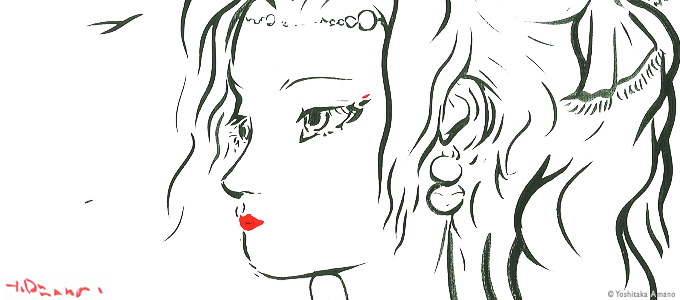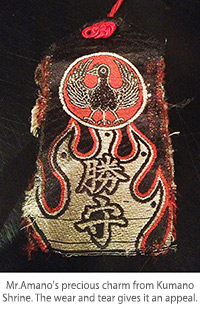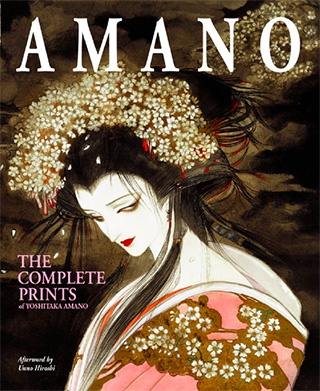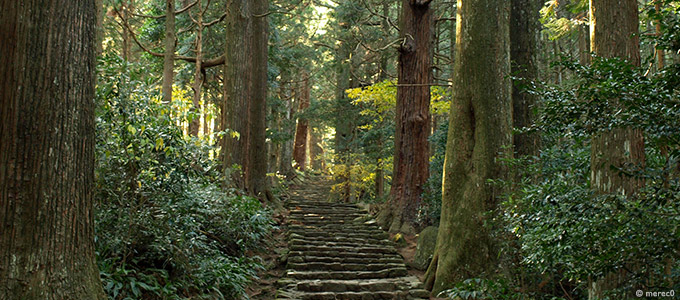
The Other Side of Fantasy
“How do I change my mental space? I put a new sheet of paper in front of me.”
Can we imagine how many sheets of paper Artist Yoshitaka Amano has laid in front of himself in the nearly 50 year-run of his life in the illustration world? The origin of his creative energy, which seems to be constantly bubbling up, is also refilled by inspirations taken from his travels. New York, Paris, Berlin, Hong Kong, São Paulo… he takes on work in places he would like to visit and goes there to receive stimulation. In Japan, he also has visited places like Ise Jinguu, Mt. Kouya, and Kumano Shrine many times.
“In Japan, I don’t really take research trips. Though I did go to the World Heritage site Kumano twice, once with a friend and once for work. It turned out to be such an inspirational visit. It’s mystical and the nature is vibrant. It’s a place where nature is winning.”

“I had a local person show me around in a car. The road between Kumano and Yoshino is a one-way street that is kind of dim. In the evening, there are places on the road that make you feel uncomfortable. It makes sense that it was a place that was important to visit to pay their respects. The main shrine of the Kumano Shrine I enjoyed especially. The omamori (talisman) I bought at Kumano was so good looking that I still keep it on me, even though it’s practically falling apart.”
“In Kumano, there are a lot of legends. There is one about the tradition of high priests getting on a boat to reach Nirvana. Of course, they had no idea back then that there were shores on the other side of the sea. So they get on the boat prepared to die. They did believe that there was Nirvana on the other side. Seems like the high priests secretly didn’t want to go. (laugh) Since Japan is surrounded by the sea it is no wonder fables like these existed.”
Artist Amano hardly ever makes sketches of the sites he visits while traveling. He takes in the inspiration wholly, lets it quietly assimilate, then he goes back to his hideout-like studio in Motoazabu. There, he lets his mind wander and the brush flows freely.
“There are two steps to creating. First it's the imagining part and that is so delightful that you could stay there forever. Within the imaginary state, I can make as many ten second sketches as I like. But the next part, the process of bringing the imagination into an actual tangible form, that is really hard work. Of course, if you don’t have the experience and certain techniques, you cannot bring it to a finish. It is challenging work to realize something that doesn’t exist. So I spend my imaginative hours in my studio in Motoazabu, and then I devote myself to the process of turning it into an art piece at the studio in Suginami.”
“Even if I am not so good at drawing, I have so much passion. With passion, you can really enjoy it, and you get better and better at it. But once you get good at it, you get more work. Then you start to speed up your process, and that’s dangerous. You start to feel like even with many jobs under your belt, it is stagnant. Basically, I would like to draw what I like, but when someone asks me to do work, I feel so appreciative; I always end up saying yes. Although, maybe it’s time I have done enough of that. (laugh)”

“Let’s say I had made 10,000 drawings so far. Added to that, let’s say I have 100 more to go. That makes it, obviously, 10,100 drawings. Well, it won't make much difference. (laugh) Anyway, so then there is a longing inside of me to use the time spent on those 100 new ones to draw whatever I want to draw.”
Artist Amano shares that what he really wants to take on next is jewelry and accessory designs related to fashion. He doesn’t have much hesitation now in spending most of his given time doing what he wants to do.
“I have always enjoyed looking at jewelry by Cartier. Actually making it and creating a product is difficult work, so I will let someone else do that part. (laugh) I like the process of imagining and sketching. When I think back, all of my drawings include designs for clothing and accessories. The jewelry, the fashion, the hair, across different styles, it’s like I have always designed all of those different aspects.”
“When I get work to design stage sets and costumes for operas or kabuki, I think of it as an extension of drawing work. Once I was asked to do the art and costume design for kabuki actor Tamasaburo Bando’s performance of Kyouka Izumi’s play “Kaijin Bessou” at the Kabuki-Za Theater. It’s a story of a human bride going to marry a prince that lives under the sea. It’s a fantasy like the Japanese classic folklore “Taro Urashima.” For that job, it also felt like the extension of my drawings; I made drawings of all the scenes and they recreated them on the stage.”
“Although they all fall into the fantasy category, when I was designing Final Fantasy, I was making more Western-style fantasy drawings. I think my work from that time has left the strongest impression of all my art, but afterwards I also worked on “The Tale of Genji” and some Japanese classics, so I really feel like I came around in full circle. Today, it doesn’t matter from what country the artist is. By sharing it, the whole world could receive it and respond to it together. It is an era where borders have no use, and the artwork’s allure stands alone.”
Artist Amano warmly cheers on today’s youth living in the times of individuality and diversity. Coming from an artist who has gone after his passion directly and honestly, his gentle yet assertive message may expand our horizon. It may help us find the key to the fantasy quest called “the modern-day.”
“It’s often said that looking at things subjectively is not good. I don’t agree. Objectively looking also ends up being a comparison. Comparing with others is useless. As long as you take on everything that intrigues you, you will always have things you need to work on. Most importantly, you have to stop looking down at society. Each person adamantly pursuing what they want is the only way. We don’t happen to live in a regressive time. Every era has its problems.”
“When I look around me, the people who are great don’t hide their uniqueness. What is most important is that they themselves truly love being that way. Even if everybody else thinks it’s weird, that very thing eventually starts to shine, so don’t worry. Of course, if you can’t find your passion, then it may not work. But you should keep searching for it. Life is so short, so by doing so, you can make it richer. After that, stuff like politics and economics won’t even matter.”
“Things you are drawn to, they actually choose you. It’s not something you can decide. They are all inevitable. I don’t think there is such a thing as coincidence. The only decision you get to make is the resolve to ‘do it,’ because you already love it. You have no choice. An artist just has to do it. People around you will judge you if you are good or not. But it’s you that is doing it. If you want to do it, then you just can’t care about anything else and just keep on with it. If you still care about what people think, then you should quit. That’s your freedom. Just don’t blame it on anybody else or the era you happen to live in. You see, doctors may diagnose you however way they see fit, but really, the person who experiences getting better is always you. Only you!”
(Interview: Manami Iiboshi, Translation: Mika Anami)
